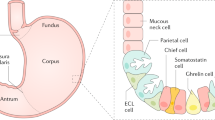Opinion statement
Menetrier’s disease is a rare acquired disorder of the fundus and body of the stomach (ie, oxyntic mucosa) characterized by giant hyperplastic folds, protein-losing gastropathy, hypoalbuminemia, increased mucus secretion, and hypochlorhydria. Recent research implicates overproduction of transforming growth factor-α with increased signaling of the epidermal growth factor receptor (EGFR) in the pathogenesis. Activation of the EGFR, a transmembrane receptor with tyrosine kinase activity, triggers a cascade of downstream, intracellular signaling pathways that leads to expansion of the proliferative compartment within the isthmus of the oxyntic gland. The diagnosis of Menetrier’s disease is based upon characteristic histologic changes, including foveolar hyperplasia, cystic dilation of pits, and reduced numbers of parietal and chief cells. The best treatment for Menetrier’s disease is not clear. It seems reasonable to test and treat for cytomegalovirus and Helicobacter pylori, as 1) in children, evidence exists that the disease may be due to cytomegalovirus infection in up to one third of patients; and 2) in adults, there are anecdotal reports of resolution upon H. pylori eradication. More recently, therapies targeting increased signaling of the EGFR have shown promise, including somatostatin analogues and monoclonal antibodies (eg, cetuximab) directed against the EGFR. In refractory cases, gastrectomy is curative.
Similar content being viewed by others
References and Recommended Reading
Coffey RJ, Washington MK, Corless CL, Heinrich MC: Menetrier disease and gastrointestinal stromal tumors: hyperproliferative disorders of the stomach. J Clin Invest 2007, 117:70–80.
Menetrier P: Des polyadenomes gastriques et de leurs rapports avec le cancer de l’estomac [in French]. Arch Physiol Norm Pathol 1888, 1:236–262.
Chen D, Aihara T, Zhao CM, et al.: Differentiation of the gastic mucosa. I. Role of histamine in control of function and integrity of oxyntic mucosa: understanding gastric physiology through disruption of targeted genes. Am J Physiol Gastrointest Liver Physiol 2006, 291:G539–G544.
Krause DS, Van Etten RA: Mechanisms of disease: tyrosine kinases as targets for cancer therapy. N Engl J Med 2005, 353:172–187.
Bublil EM, Yarden Y: The EGF receptor family: spearheading a merger of signaling and therapeutics. Curr Opin Cell Biol 2007, 19:124–134.
Schubert ML, McCuen RW, Settle SL, Coffey RJ: Epidermal growth factor-related peptides regulate somatostatin, histamine, and gastrin secretion in human and rat stomach [abstract]. Gastroenterology 2003, 124:443.
Bluth RF, Carpenter HA, Pittelkow MR, et al.: Immunolocalization of transforming growth factor-alpha in normal and diseased human gastric mucosa. Hum Pathol 1995, 26:1333–1340.
Konstantinidou AE, Morphopoulos G, Korkolopoulou P, et al.: Menetrier disease of early infancy: a separate entity? J Pediatr Gastroenterol Nutr 2004, 39:177–182.
Dempsey PJ, Goldenring J, Soroka CJ, et al.: Possible role of transforming growth factor alpha in the pathogenesis of Menetrier’s disease: supportive evidence from humans and transgenic mice. Gastroenterology 1992, 103:1950–1963.
Geist M, Fich A, Mogle P: Menetrier’s disease: evolution of disease under histamine-2 receptor antagonists. Am J Gastroenterol 1992, 87:648–650.
Ogawa T, Maeda K, Tonai S, et al.: Utilization of knockout mice to examine the potential role of gastric histamine H2-receptors in Menetrier’s disease. J Pharmacol Sci 2003, 91:61–70.
Sferro TJ, Pawel BR, Quaiman SJ, Li BU: Menetrier disease of childhood: role of cytomegalovirus and transforming growth factor alpha. J Pediatr 1996, 128:213–219.
Kuzuya G, Kumada T, Kiriyama S, et al.: Contrast-enhanced ultrasonographic assessment of the response of Menetrier disease to Helicobacter pylori eradication therapy. J Ultrasound Med 2006, 25:1099–1103.
Bayerdörffer E, Ritter MM, Hatz R, et al.: Healing of protein losing hypertrophic gastropathy by eradication of Helicobacter pylori: is Helicobacter pylori a pathogenic factor in Menetrier’s disease? Gut 1994, 35:701–704.
Madsen LG, Taskiran M, Madsen JL, Bytzer P: Menetrier’s disease and Helicobacter pylori: normalization of gastrointestinal protein loss after eradication therapy. Dig Dis Sci 1999, 44:2307–2312.
Meuwissen SG, Ridwan BU, Hasper HJ, Innemee G: Hypertrophic protein-losing gastropathy. Scand J Gastroenterol 1992, 27:1–7.
Wood GM, Bates C, Brown RC, Losowsky MS: Intramucosal carcinoma of the gastric antrum complicating Menetrier’s disease. J Clin Pathol 1983, 36:1071–1075.
Ba-Ssalamah A, Prokop M, Uffmann M, et al.: Dedicated multidetector CT of the stomach: spectrum of diseases. Radiographics 2003, 23:625–644.
Okanobu H, Hata J, Haruma K, et al.: Giant gastric folds: differential diagnosis at US. Radiology 2003, 226:686–690.
Yeaton P, Frierson H: Octreotide reduces enteral protein losses in Menetrier’s disease. Am J Gastroenterol 1993, 88:95–98.
Gadour MO, Salman AH, El Samman EE, Tadros NM: Menetrier’s disease: an excellent response to octreotide. A case report from the Middle East. Trop Gastroenterol 2005, 26:129–131.
Green PT, Branch MS: Menetrier’s disease treated with octreotide long-acting release. Gastrointest Endosc 2004, 60:1028–1029.
Burdick JS, Chung EK, Tanner G, et al.: Treatment of Menetrier’s disease with a monoclonal antibody against the epidermal growth factor receptor. N Engl J Med 2000, 343:1697–1701.
Settle SH, Washington K, Lind C, et al.: Chronic treatment of Menetrier’s disease with Erbitux: clinical efficacy and insight into pathophysiology. Clin Gastroenterol Hepatol 2005, 3:654–659.
Hoffer V, Finkelstein Y, Balter J, et al.: Ganciclovir treatment in Menetrier’s disease. Acta Paediatr 2003, 92:983–985.
Hubbard SR, Miller WT: Receptor tyrosine kinases: mechanisms of activation and signaling. Curr Opin Cell Biol 2007, 19:117–123.
Author information
Authors and Affiliations
Corresponding author
Rights and permissions
About this article
Cite this article
Toubia, N., Schubert, M.L. Menetrier’s disease. Curr Treat Options Gastro 11, 103–108 (2008). https://doi.org/10.1007/s11938-008-0022-x
Published:
Issue Date:
DOI: https://doi.org/10.1007/s11938-008-0022-x




